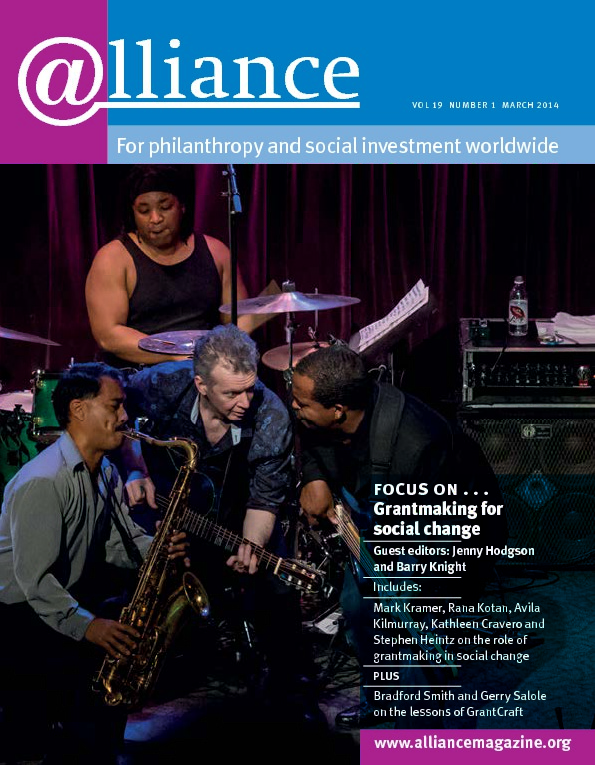When America sneezes, Europe catches a cold, it was said of the 1929 Wall Street crash. In philanthropy, the US usually leads, Europe follows, and the rest of the world eventually catches up. In the case of giving circles, it looks like Asia may be catching the cold before Europe. Collective giving, well established in the US, is a growing phenomenon in Asia, from India to New Zealand, Singapore to Beijing, while we identified only a handful of giving circles in Europe.
A giving circle is a group of individuals who pool their resources and together support a number of non-profits, usually with a mix of finance and business advice. Giving circles vary widely. Some are formally structured and employ staff or partner with community foundations for day-to-day management. Many are self-administering, with members active across the grant management cycle from shortlisting and evaluation to impact reporting. Some are so informal as to be effectively invisible.
Estimates from 2009 put the number of giving circles in the US at ‘well over 500’, not counting those below the ‘water line’. While many of these are independent, a significant number are affiliated to networks such as SVP (Social Venture Partners), Impact100, the Awesome Foundation or the Women’s Collective Giving Grantmaking Network. Many comprise women only, while others may reflect a particular ethnic or religious affiliation. Despite their diversity, giving circles seem to have five core characteristics (see box).
Five core characteristics of giving circles
• Individuals pool and collectively give away resources.
• Circles provide a means for educating members about philanthropy, non-profits and local issues.
• They offer ‘social with purpose’ opportunities for members.
• They engage members in the grant process and sometimes in providing non-profits with other support such as advice or mentoring.
• They do not support a single non-profit exclusively. Members choose a number of organizations that reflect their interests and priorities.
Source: Adapted from Eikenberry (2009)[1] and others.
Our recent study found nearly 30 groups established or starting up in Asia.[2] Some were launched as affiliates to networks outside Asia; others were indigenous initiatives. And these are just the visible groups: the ‘iceberg effect’ is likely to be more significant in Asia, where giving is culturally a much less public affair than in the US, with fewer incentives for tax efficiency that require disclosure. While we uncovered few giving circles in Europe, recent research suggests numbers are growing in the UK and Ireland.[3]
Imported models
Of these 30 groups, the majority had been ‘imported’ from existing initiatives in the West under some form of licensed arrangement. SVP was founded in the US in the mid-1990s and grew over 15 years to a network of 27 North American circles, plus an outlying chapter in Tokyo. In 2013 SVP embarked on an ambitious expansion into Asia, with initiatives seeded in India (see box), China and Australia.[4] Impact100 is a women’s giving circle with chapters in 16 US cities; it opened its first non-US chapter, in Melbourne, two years ago. Its premise is straightforward: ‘100 people each give US$1,000 for high-impact grantmaking.’ The Funding Network (TFN), which runs events where charities pitch for funding, originated in London and is now expanding internationally, including in Sydney and Singapore. The Awesome Foundation, a relatively new giving circle network, utilizes social media and a fresh language to attract younger professionals. It has grown from a single Boston chapter in 2010 to 52 circles globally, including nine in Asia.
For giving circles linked to western initiatives to be relevant in Asia, they will need to adapt imported practices to local cultural and regulatory contexts. For example, SVP India has introduced a federated structure and has both national and local sector priorities; Awesome Foundation’s Asian chapters tend to support more traditionally ‘charitable’ initiatives than their US counterparts; one circle in Japan has inspired the setting up of a giving circle within a major financial services firm.
Social Venture Partners India
As chair of Microsoft India, Ravi Venkatesan came into close contact with SVP’s Seattle chapter. He saw that its collective giving model could be relevant for the burgeoning professional class in India’s own ‘silicon valley’. In 2012, after stepping down from Microsoft and with financial and moral support from several Seattle partners, he launched SVP India’s first chapter in Bangalore. By the end of 2013 it had 65 partners, each committing at least US$3,200 annually. It will focus on the environmental problem of waste management in one of India’s fastest-growing cities, in addition to general grantmaking to promising local non-profits.
Ravi sees the SVP model as a starting point for India. We need to be ‘entrepreneurially opportunistic’, he says, and ‘run lots of experiments and from those figure out what’s worth pursuing’. SVP India will provide an umbrella structure for other chapters, planned for Mumbai and Pune in 2014, with others in the pipeline. Like Bangalore, each will champion a local issue and contribute to SVP India’s nationwide priority of creating sustainable jobs.
SVP India will also have an impact on the parent SVP, until 2013 largely a North American network. As India adapts a core model suitable for the Indian context, where scale of impact is a given, its learning and experience will shape the future of the global network.
Indigenous models
A small but important minority of the circles we found in Asia originated locally with no explicit connection to a foreign model. Dasra is a purely Indian organization that has pioneered venture philanthropy since 2000 and provides peer-learning platforms for social entrepreneurs and philanthropists. Its six themed giving circles are now India’s largest collaborative giving effort. Each circle is convened in response to research on a pressing social issue, such as malnutrition in slums, public education in Mumbai or sport for development. Wealthy individuals each contribute at least $60,000 over the three-year lifetime of a circle. Circle members use the research to help select the non-profit they believe can best address the issue, drawn from a list of organizations pre-screened by Dasra. Dasra, together with circle members, provides a package of consulting support and growth finance to help it scale up. The size of each circle’s fund (up to US$600,000) and the strength of a research-based approach make Dasra’s model one that western philanthropists might follow.
Liza and Chris Green, a successful expatriate family working in Hong Kong’s financial services industry, launched New Day Asia in 2007. It is now an 80-strong giving circle of both expatriates and permanent residents who pledge a monthly minimum of just HK$500 (US$65). This modest sum allows access to anyone who wants to experiment with collective giving. The circle relies entirely on members and their friends and colleagues volunteering their time. It has supported projects in Cambodia, Tibet, India and Nepal that focus on abused women and girls. From the start Liza, who runs the circle’s day-to-day operations, encouraged active member involvement in searching for new projects, and visiting and monitoring the progress of organizations they support. The circle also includes a number of corporates, such as law firm Linklaters, which provide co-funding for projects, and to which New Day Asia can offer a philanthropy service for its staff.
Why is collective philanthropy important for Asia?
Philanthropy in Asia is developing rapidly as a fusion of western and local practices. To have impact in a region with pressing social and environmental problems, it must be strategic across the whole spectrum of giving. It must also compete for attention and capital with the fashionable trend of impact investing, which can sometimes portray philanthropy as a lesser activity. Giving circles can help shape the knowledge, attitudes and practices of a generation of new philanthropists, and be a starting point for the lifelong activity of intelligent giving.
Examples of giving circles in Asia

1 Eikenberry et al (2009) The Impact of Giving Together. Forum of Regional Associations of Grantmakers, Center on Philanthropy at Indiana University and University of Nebraska at Omaha. Available at http://www.givingforum.org
2 Rob John (2014) Virtuous Circles: The emergence of collective philanthropy in Asia. Entrepreneurial Social Finance Working Paper 3, Asia Centre for Social Entrepreneurship & Philanthropy, NUS Business School, Singapore. Available at http://bschool.nus.edu/ResearchPublications/ResearchCentres/ACSEPHome/Research.aspx
3 Unpublished research by Angela Eikenberry and Beth Breeze puts the number of giving circles in the UK and Ireland at around 80 (personal communication).
4 See Ruth Jones, ‘Engaged philanthropy catching on globally’ at http://philanthropynews.alliancemagazine.org/engaged-philanthropy-catching-on-globally
Rob John is a senior visiting fellow at the Asia Centre for Social Entrepreneurship & Philanthropy, NUS Business School, Singapore, and a co-founder of AVPN. Email rob.john@nus.edu.sg






Comments (0)